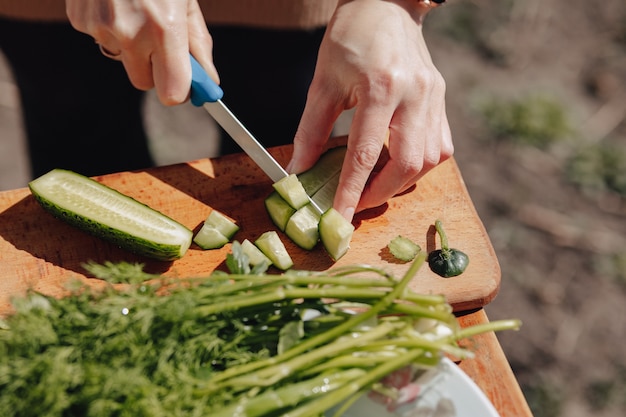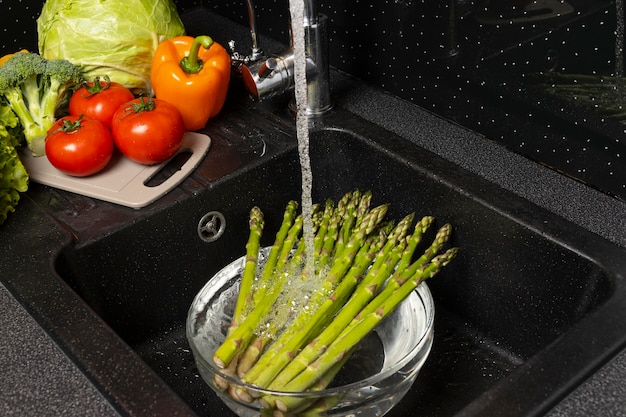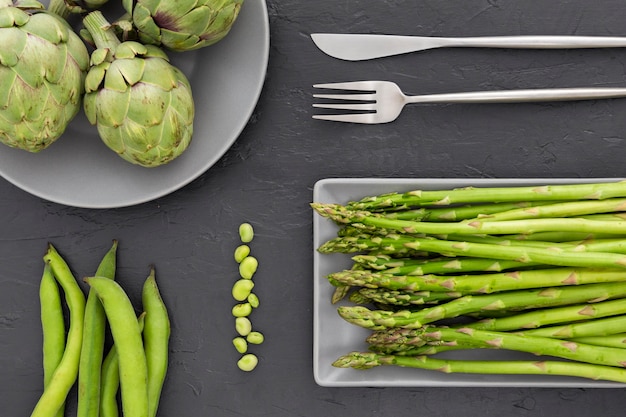Ah, asparagus! The mere mention of those emerald green spears conjures up images of spring, fresh air, and delicious meals. But let's be honest, even the most seasoned cook can feel a little intimidated when it comes to asparagus. How long do you cook it? How do you know when it's done? What's the secret to getting that perfect, tender-crisp texture? I've been there, believe me. There was a time when my asparagus was either limp and overcooked or, worse, still crunchy and tough. But fear not! Over the years, I've learned a thing or two about mastering this springtime delight. I'm going to share all my secrets and tips to ensure you never have another asparagus disaster again. Let's embark on this culinary journey together, from selecting the perfect spears to achieving the perfect tenderness.
(Part 1) Choosing the Right Asparagus

The first step to achieving asparagus perfection is selecting the right spears. Think of it as a choose-your-own-adventure for your taste buds! Here's what to look for:
1.1) Size Matters
Asparagus comes in various sizes, and each has its own unique characteristics.
- Thin spears: These are delicate and cook quickly, perfect for a light and flavorful side dish. They're often the most tender, but they can also be a bit more fragile and prone to breaking. Think of them as the dainty dancers of the asparagus world.
- Medium spears: These are the most common and versatile, offering a good balance of tenderness and substance. They're a great choice for most recipes. These are your reliable all-rounders.
- Thick spears: These are robust and hold up well to grilling or roasting. They need a bit more cooking time and are perfect for hearty dishes. Think of these as the strong and sturdy members of the asparagus family.
1.2) Colour Counts
Asparagus colour can also give you hints about its flavour and tenderness:
- Green asparagus: This is the most common type and has a bright, vibrant flavour. It's the classic, dependable asparagus that everyone knows and loves.
- White asparagus: These are grown underground and have a milder, more delicate flavour. They often require longer cooking times. Think of these as the more subtle and nuanced cousins of the green asparagus.
- Purple asparagus: This variety is a bit sweeter and has a more intense flavour than green asparagus. They are usually a little more expensive. These are the showstoppers of the asparagus world, offering a vibrant flavour and a touch of luxury.
1.3) The Importance of Freshness
Freshness is key! Look for asparagus that is firm, crisp, and free from any wilting or discoloration. The tips should be tightly closed and the spears should feel heavy for their size. This means they're full of moisture and flavour. And if you're buying asparagus from a farmers' market, don't hesitate to ask the vendor for their recommendations based on your needs and preferences. They'll be happy to guide you to the perfect spears for your culinary adventure.
(Part 2) Preparing Your Asparagus

Once you've got your perfect asparagus, it's time to prepare them for their culinary transformation. This might seem like a simple step, but trust me, getting it right makes a world of difference. Here's my tried-and-true method:
2.1) Trimming the Ends
The woody end of the asparagus spear needs to be trimmed off. It's tough, fibrous, and frankly, no fun to eat. To find the right spot, simply bend the spear at the bottom until it snaps. This is where the tender part begins, and you can discard the woody portion.
2.2) Washing the Spears
A good wash is essential! Rinse the asparagus spears under cold running water, making sure to remove any dirt or grit. If you're feeling extra fancy, you can use a vegetable brush to give them a thorough scrub. This ensures your asparagus is clean and ready for cooking.
2.3) Peeling for a Smoother Texture
Now, here's where I like to get a bit more hands-on. I've found that peeling thicker asparagus spears (especially white asparagus) can enhance their tenderness. Use a vegetable peeler to gently peel the outer layer from the bottom up to about halfway along the spear. This helps remove any tough outer skin and gives you a smoother, more palatable texture. You can choose to peel or not, depending on your preferences and the type of asparagus you're using.
(Part 3) Stovetop Cooking Methods

Let's get to the heart of the matter, shall we? Stovetop cooking is my go-to method for asparagus, especially when I'm looking for a quick and simple side dish. The possibilities are endless, and you can experiment with different techniques to suit your taste. Here's a breakdown of my top favourites:
3.1) Simple Boiling
This is a classic and foolproof method. It's perfect for preserving the asparagus's natural flavour and colour. You can use a large pot filled with salted water, bringing it to a rolling boil before adding the asparagus. Cook for about 3-5 minutes, or until tender-crisp. Remember to test the asparagus spears for doneness by piercing them with a fork. Once they offer minimal resistance, they're ready.
3.2) Sautéing with Garlic
Ah, garlic and asparagus, a match made in culinary heaven! Sautéing adds a delightful flavour and aroma to your asparagus. Heat some olive oil in a pan over medium heat. Add the asparagus and cook for 3-5 minutes, tossing occasionally. Then, throw in some minced garlic and continue cooking for another minute or so. Season with salt, pepper, and a squeeze of lemon juice for a burst of freshness.
3.3) Stir-frying for a Speedy Feast
Stir-frying is a great way to cook asparagus quickly and efficiently. Heat a wok or large skillet over high heat. Add a splash of oil and toss in your asparagus spears. Stir-fry for 2-3 minutes, until tender-crisp. This method works well with other vegetables and proteins, creating a delicious and satisfying stir-fry meal.
(Part 4) How to Know When Asparagus is Done
The biggest fear for any aspiring asparagus chef is overcooking! It's a delicate dance, and knowing when your asparagus is perfect requires a little bit of practice and some key indicators. Here's what to look for:
4.1) The Fork Test
This is my go-to method for checking doneness. Pierce the thickest part of an asparagus spear with a fork. If it offers minimal resistance and slides in easily, it's ready. If it feels tough or you feel any resistance, it needs a little more time. Remember, you want it tender-crisp, not limp and overcooked.
4.2) The Colour Check
Asparagus spears will change colour as they cook. They'll turn a brighter shade of green and become more vibrant. Don't be afraid to check the colour of your spears as they cook. If they start to lose their vibrant hue and become dull, they might be overcooked.
4.3) The Feel Test
Once your asparagus has softened, test it by gently squeezing a spear between your fingers. It should feel tender but still have a slight snap to it. If it feels limp and mushy, you've gone too far.
(Part 5) Mastering the Timing
The cooking time for asparagus will vary depending on the size of the spears, the cooking method, and your desired texture. Here's a general guideline to get you started:
5.1) Cooking Time Chart
To make things a bit easier, I've created a simple cooking time chart for different methods and asparagus sizes:
| Asparagus Size | Boiling (minutes) | Sautéing (minutes) | Stir-frying (minutes) |
|---|---|---|---|
| Thin | 2-3 | 3-4 | 2-3 |
| Medium | 3-5 | 4-6 | 3-4 |
| Thick | 5-7 | 6-8 | 4-5 |
Remember, this is just a guideline. Always check your asparagus for doneness using the methods I mentioned earlier. Don't be afraid to adjust the cooking time based on your specific asparagus and your desired texture.
(Part 6) Seasoning and Serving
The magic of asparagus is that it's incredibly versatile. It can be enjoyed as a simple side dish, incorporated into a main course, or even used to create delightful appetizers. The key is to find the right seasoning and presentation to complement its natural flavour.
6.1) Seasoning Ideas
Here are some of my favourite ways to season asparagus:
- Classic: Salt, pepper, and a squeeze of lemon juice are all you need for a simple yet delicious flavour. This is a timeless combination that enhances the asparagus' natural sweetness.
- Garlic Lovers: Sauté your asparagus with garlic and a drizzle of olive oil for a savoury and aromatic twist. The garlic adds a pungent aroma and a delightful flavour profile to the asparagus.
- Citrus Burst: Add a bit of orange zest or a splash of orange juice to your asparagus for a refreshing and bright flavour. This brings a citrusy tang and a touch of sweetness to the asparagus, making it a perfect pairing for seafood or grilled chicken.
- Herby Delight: Sprinkle some chopped fresh herbs like parsley, dill, or chives over your asparagus for a fragrant touch. The herbs add a burst of freshness and a delicate flavour to the asparagus, complementing its earthy notes.
- Spicy Kick: Add a pinch of red pepper flakes for a touch of heat. This adds a touch of warmth and a bit of fire to the asparagus, creating a delightful contrast to its earthy sweetness.
6.2) Serving Suggestions
Here are a few ideas to get your creative juices flowing:
- Side Dish: Serve your asparagus alongside grilled fish, chicken, or steak. It adds a vibrant touch of colour and a refreshing crunch to any protein-based meal.
- Salad: Add chopped asparagus to a mixed green salad for a unique and satisfying crunch. The asparagus adds a lovely texture and a distinct flavour to the salad, making it more interesting and complex.
- Soup: Use asparagus in a soup, either as a main ingredient or as a garnish. It adds a delicate sweetness and a lovely green colour to the soup, making it visually appealing and flavourful.
- Pasta: Toss cooked asparagus with your favourite pasta dish. It adds a lovely texture and a distinct flavour to the pasta, making it more interesting and complex.
- Appetizer: Wrap asparagus spears in bacon or prosciutto and bake until crispy. This creates a decadent and flavorful appetizer that's perfect for any occasion.
(Part 7) Storage and Leftovers
You've created asparagus magic, and now you have some leftovers. Don't let them go to waste! Here's how to store and reuse them:
7.1) Storing fresh asparagus
To keep your asparagus fresh for longer, wrap the base of the spears in a damp paper towel and store them in an airtight container in the refrigerator for up to 5 days. This helps retain the moisture and prevent wilting.
7.2) Storing Cooked Asparagus
Cooked asparagus can be stored in an airtight container in the refrigerator for up to 3 days. To reheat it, simply toss it in a pan with a little bit of olive oil or water and heat it over medium heat until warmed through. You can also reheat it in the microwave.
7.3) Using Leftover Asparagus
Don't let those leftovers go to waste! Here are a few ideas to use them up:
- asparagus salad: Add chopped leftover asparagus to a salad for extra flavour and texture. It adds a nice crunch and a burst of flavour to the salad.
- asparagus omelette: Mix leftover asparagus with your favourite omelette ingredients. It adds a delicious veggie element to the omelette and makes it more substantial.
- asparagus soup: Blend cooked asparagus with broth and spices to create a delicious soup. It creates a creamy and flavorful soup that's packed with nutrients.
(Part 8) Asparagus FAQs
I know what you're thinking: you've got questions about asparagus, and I'm here to answer them! Let's dive into some common queries:
8.1) Can you eat the asparagus peelings?
If you're peeling your asparagus, you can compost the peelings or toss them in your garden as a natural fertilizer. They're not typically eaten because they tend to be tough and fibrous.
8.2) Why does asparagus make my pee smell?
This is a common reaction to asparagus! It's caused by a sulfurous compound called asparagusic acid. Don't worry, it's perfectly normal.
8.3) Can you eat raw asparagus?
You can eat raw asparagus, but it's quite tough and can be a bit challenging to digest. It's best to cook it for a more tender and enjoyable experience.
8.4) Is asparagus good for you?
Asparagus is packed with nutrients and antioxidants! It's a great source of vitamins, minerals, and fiber. It's a low-calorie and nutrient-rich vegetable that can be enjoyed as part of a healthy diet.
8.5) What are some good substitutes for asparagus?
If you're looking for a substitute for asparagus, try other green vegetables like broccoli, green beans, or snap peas. These vegetables have similar textures and can be cooked in similar ways. They offer similar nutritional benefits and can be used in various recipes.
(Part 9) Conclusion
Mastering asparagus on the stovetop is an art form! But with a little practice and these tips, you'll be a pro in no time. So, the next time you see those beautiful spears at the market, don't be afraid to grab a bunch and unleash your inner chef. Remember, the key is to choose the right asparagus, prepare it properly, and cook it to your desired texture. And don't forget to have fun with it! Experiment with different flavours, techniques, and recipes to discover your own asparagus favourites.
Everyone is watching

Corn on the Cob: The Ultimate Guide to Perfectly Cooked Ears
Healthy MealsAh, corn on the cob. Just the name evokes images of sunny days, barbecues, and that sweet, juicy flavour that ...

Perfect Pork Roast Oven Cooking Time: A Guide to Delicious Results
Healthy MealsThere's something truly satisfying about a perfectly roasted pork. The aroma alone is enough to make your mout...

Scallops: The Ultimate Guide to Perfect Cooking
Healthy MealsAh, scallops. Those delicate, sweet, and utterly delicious morsels of the sea. They hold a special place in my...

Spaghetti Squash: The Ultimate Guide to Cooking and Serving
Healthy MealsRemember that time you saw spaghetti squash at the supermarket, looking all bumpy and strange, and thought, "W...

Ham Cooking Time: How Long to Bake, Smoke, or Boil a Delicious Ham
Healthy MealsAh, ham. It's a classic, isn't it? A real crowd-pleaser, especially around holidays. And when done right, it'...
